The global automotive brake hoses and assemblies market is projected to grow from USD 3,047.3 million in 2025 to approximately USD 5,059.1 million by 2035, recording an absolute increase of USD 2,011.8 million over the forecast period. This translates into a total growth of 66.0%, with the market forecast to expand at a compound annual growth rate (CAGR) of 5.2% between 2025 and 2035. The overall market size is expected to grow by nearly 1.66X during the same period, supported by increasing global vehicle production, growing emphasis on automotive safety systems, and rising adoption of advanced braking technologies across passenger cars and commercial vehicles worldwide.
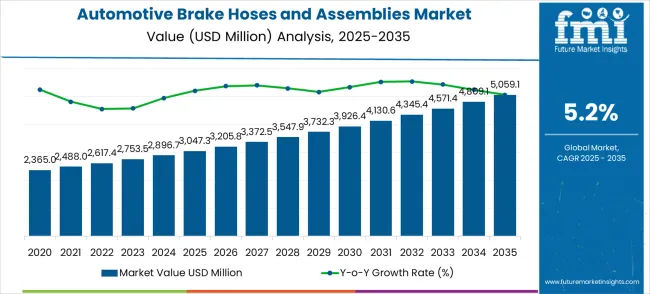
| Metric | Value |
|---|---|
| Estimated Value in (2025E) | USD 3,047.3 million |
| Forecast Value in (2035F) | USD 5,059.1 million |
| Forecast CAGR (2025 to 2035) | 5.2% |
From 2030 to 2035, the market is forecast to grow from USD 3,837.1 million to USD 5,059.1 million, adding another USD 1,222.0 million, which constitutes 60.7% of the overall ten-year expansion. This period is expected to be characterized by the integration of advanced materials technology, the development of lightweight brake hose solutions for electric vehicles, and the advancement of high-pressure resistant assemblies for enhanced braking performance. The growing emphasis on sustainable automotive manufacturing and the adoption of electric cars will drive demand for specialized brake hoses and assemblies with improved durability, reduced weight, and enhanced performance characteristics for next-generation braking systems.
Between 2020 and 2024, the automotive brake hoses and assemblies market experienced steady growth, driven by increasing global vehicle production and growing recognition of brake system reliability's critical importance for vehicle safety and performance. The market developed as automotive manufacturers recognized the potential for advanced brake hoses and assemblies to enhance braking system efficiency while meeting stringent safety requirements. Technological advancement in rubber compounds, reinforcement materials, and manufacturing processes began emphasizing the critical importance of maintaining hydraulic integrity while extending service life and improving cost-effectiveness.
Market expansion is being supported by the increasing global demand for reliable braking systems and the corresponding shift toward advanced brake technologies that can provide enhanced safety performance while meeting modern automotive requirements for durability and efficiency. Modern automotive manufacturers are increasingly focused on incorporating high-quality brake hoses and assemblies to enhance vehicle safety performance while satisfying regulatory demands for advanced braking systems and improved stopping power capabilities. Brake hoses and assemblies' proven ability to deliver superior hydraulic transmission, operational reliability, and safety enhancement makes them essential components for modern automotive brake system development and vehicle safety applications.
The growing emphasis on electric vehicle development and advanced automotive technologies is driving demand for specialized brake hose systems that can support regenerative braking integration and real-time communication with electronic brake control systems across passenger cars, commercial vehicles, and specialty automotive applications. Automotive manufacturers' preference for components that combine performance excellence with lightweight design credentials is creating opportunities for innovative brake hose implementations in both traditional and emerging automotive applications. The rising influence of autonomous vehicle development and advanced driver assistance systems is also contributing to increased adoption of high-performance brake hoses and assemblies that can provide reliable hydraulic transmission for automated braking systems and safety-critical applications.
The automotive brake hoses and assemblies market represents a critical growth opportunity as the global automotive industry undergoes unprecedented transformation. With the market expanding from USD 3,047.3 million in 2025 to USD 5,059.1 million by 2035 at a robust 5.2% CAGR, stakeholders face compelling opportunities driven by increasing vehicle production, the adoption of electric vehicles, and stringent safety regulations worldwide.
The convergence of traditional automotive manufacturing with electric vehicle technologies, autonomous driving systems, and advanced materials science is creating substantial demand for specialized brake components. High-growth markets LED by China (7.0% CAGR) and India (6.5% CAGR) offer significant volume expansion, while developed markets emphasize premium performance and advanced technology integration.
OEM applications dominate the market landscape, representing the largest demand segment, while hydraulic systems maintain technological leadership. The shift toward electric vehicles, lightweight materials, and integrated safety systems provides structural growth drivers, supported by global regulatory frameworks prioritizing vehicle safety and environmental sustainability.
The market is segmented by operating mechanism, application, and region. By operating mechanism, the market is divided into hydraulic and pneumatic categories. Based on application, the market is categorized into automotive OEM and automotive aftermarket. Regionally, the market is divided into North America, Europe, East Asia, South Asia & Pacific, Latin America, and the Middle East & Africa.
The hydraulic segment is projected to dominate with 25.9% the automotive brake hoses and assemblies market in 2025, maintaining its position as the leading operating mechanism category. Automotive manufacturers and brake system suppliers increasingly utilize hydraulic brake hoses for their superior pressure transmission characteristics, precise braking control capabilities, and established compatibility with modern brake system architectures across diverse vehicle applications. Hydraulic technology's proven pressure handling performance and responsive braking characteristics directly address the operational requirements for effective brake force transmission and reliable stopping power in both passenger cars and commercial vehicles.
This operating mechanism segment forms the foundation of modern automotive braking applications, as it represents the technology with the greatest versatility and established automotive compatibility across multiple vehicle platforms and braking systems. Automotive manufacturer investments in hydraulic brake technology solutions and performance optimization continue to strengthen adoption among vehicle manufacturers and brake system suppliers. With automotive companies prioritizing operational effectiveness and consistent braking performance, hydraulic brake hoses align with both safety objectives and performance assurance requirements, making them the central component of comprehensive automotive braking strategies.
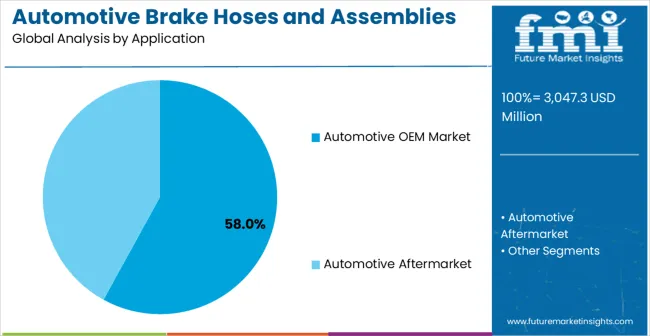
Automotive OEM applications are projected to represent 58% market share of brake hoses and assemblies demand in 2025, underscoring their critical role as the primary application environment for original equipment brake system integration. Automotive manufacturers prefer brake hoses and assemblies for their ability to meet stringent quality standards efficiently, support vehicle safety certification requirements, and provide reliable braking performance while offering consistent manufacturing specifications for mass production applications. Positioned as essential components for modern vehicle manufacturing, brake hoses and assemblies offer both performance advantages and quality assurance benefits.
The segment is supported by continuous growth in global vehicle production and the growing implementation of advanced safety systems that enable enhanced braking performance and real-time brake system monitoring at the vehicle manufacturing level. Additionally, automotive OEM manufacturers are investing in advanced brake technologies to support high-performance braking positioning and vehicle safety optimization. As global vehicle production continues to expand and manufacturers seek reliable brake components, automotive OEM applications will continue to dominate the application landscape while supporting manufacturing efficiency and vehicle safety enhancement strategies.
The automotive brake hoses and assemblies market is advancing steadily due to increasing global vehicle production and growing demand for advanced braking systems that emphasize reliable hydraulic transmission across passenger car and commercial vehicle applications. However, the market faces challenges, including raw material price volatility affecting rubber and reinforcement materials, stringent automotive safety regulations requiring extensive testing and certification, and competition from alternative braking technologies in electric vehicle applications. Innovation in lightweight materials technology and advanced manufacturing processes continues to influence market development and expansion patterns.
The growing adoption of brake hoses and assemblies in electric vehicle development and advanced automotive technology projects is enabling automotive manufacturers to develop vehicles that provide enhanced braking performance while supporting integrated regenerative braking systems and advanced driver assistance system compatibility. Electric vehicle applications offer superior energy efficiency opportunities while allowing more sophisticated brake system development across various automotive categories and vehicle segments. Automotive manufacturers are increasingly recognizing the performance advantages of specialized brake hose positioning for electric vehicle development and advanced automotive system integration.
Modern brake hose and assembly suppliers are incorporating high-performance rubber compounds, advanced reinforcement materials, and precision manufacturing systems to enhance braking performance reliability, improve product durability, and meet the demands of automotive manufacturers for consistent quality and performance standards. These technologies enhance operational efficiency while enabling new applications, including high-pressure brake systems and lightweight automotive applications. Advanced materials integration also allows automotive manufacturers to support enhanced braking performance, positioning, and vehicle weight optimization beyond traditional brake hose technologies.
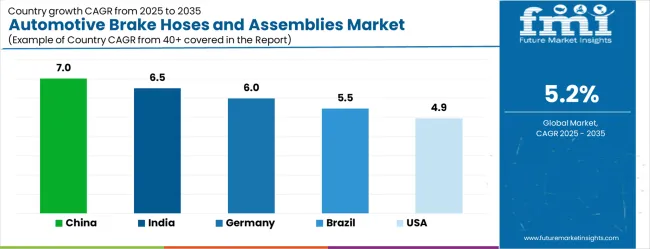
| Country | CAGR (2025-2035) |
|---|---|
| China | 7.0% |
| India | 6.5% |
| Germany | 6.0% |
| Brazil | 5.5% |
| U.S. | 4.9% |
| U.K. | 4.4% |
| Japan | 3.9% |
The automotive brake hoses and assemblies market is experiencing robust growth globally, with China leading at a 7.0% CAGR through 2035, driven by massive automotive production expansion, growing domestic vehicle demand, and government support for automotive manufacturing industry development across major automotive manufacturing hubs. India follows at 6.5%, supported by rapid automotive industry growth, increasing vehicle affordability, and rising adoption of safety-focused vehicle technologies. Germany shows growth at 6.0%, emphasizing advanced automotive engineering and premium vehicle manufacturing excellence. Brazil records 5.5%, focusing on automotive manufacturing expansion and domestic vehicle market development. The U.S. demonstrates 4.9% growth, prioritizing automotive safety enhancement and advanced braking technology integration. The U.K. exhibits 4.4% growth, supported by automotive manufacturing modernization and safety regulation compliance programs. Japan shows 3.9% growth, supported by advanced automotive technology development and precision manufacturing capabilities.
The report covers an in-depth analysis of 40+ countries top-performing countries are highlighted below.
Revenue from automotive brake hoses and assemblies in China is projected to exhibit exceptional growth with a CAGR of 7.0% through 2035, driven by the country's massive automotive production expansion and increasing investments in domestic vehicle manufacturing across growing automotive manufacturing centers and export market development. The country's increasing focus on electric vehicle production and automotive safety enhancement is creating substantial demand for advanced brake hose technologies in both conventional and electric vehicle applications. Major automotive manufacturers and brake component suppliers are establishing comprehensive production capabilities to serve both domestic vehicle production requirements and international export market opportunities.
Automotive brake hoses and assemblies market in India is expanding at a CAGR of 6.5%, supported by rapid automotive industry growth, increasing vehicle affordability programs, and growing government investments in automotive manufacturing infrastructure and vehicle safety enhancement initiatives. The country's developing automotive manufacturing capabilities and expanding domestic vehicle market are driving demand for reliable brake components across both passenger car and commercial vehicle applications. International automotive component companies and domestic brake system manufacturers are establishing comprehensive production and distribution capabilities to address growing market demand for automotive brake hoses and assemblies.
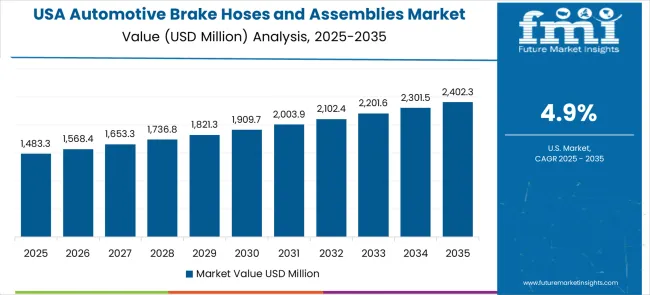
Demand for automotive brake hoses and assemblies market in the United States is projected to grow at a CAGR of 4.9% through 2035, driven by the country's comprehensive automotive safety regulations, advanced automotive manufacturing capabilities, and increasing adoption of electric vehicles requiring specialized brake system components across passenger car and commercial vehicle segments. The U.S.'s established automotive manufacturing infrastructure and significant investments in vehicle safety enhancement are creating substantial demand for high-performance brake hose and assembly technologies. Leading automotive manufacturers and brake component suppliers are establishing comprehensive production strategies to serve both domestic vehicle manufacturing and automotive aftermarket requirements.
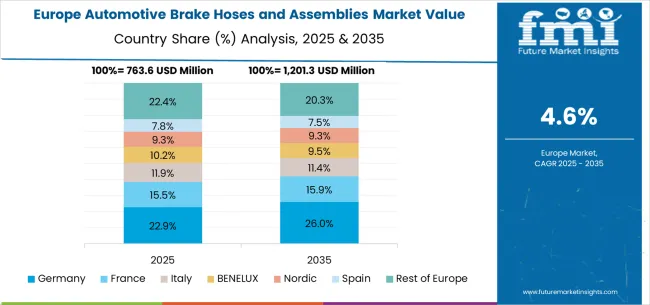
Revenue from automotive brake hoses and assemblies in Germany is projected to grow at a CAGR of 6.0% through 2035, supported by the country's advanced automotive engineering capabilities, premium vehicle manufacturing industry, and established tradition of automotive innovation requiring high-performance brake system components. German automotive manufacturers and brake component suppliers consistently demand superior brake hose and assembly products that meet exacting quality standards for both domestic premium vehicle production and export market applications. The country's position as an automotive technology leader continues to drive innovation in brake hose applications and performance standards.
Automotive brake hoses and assemblies in Brazil is expected to grow at a CAGR of 5.5% through 2035, supported by the country's expanding automotive manufacturing industry, domestic vehicle market development programs, and increasing investments in automotive component production across major automotive manufacturing regions and vehicle assembly facilities. Brazilian automotive manufacturers prioritize cost-effective solutions, operational reliability, and safety compliance, making brake hoses and assemblies essential components for both domestic vehicle production and automotive aftermarket applications. The country's comprehensive automotive manufacturing development programs and regional automotive initiatives support continued brake component market development.
Automotive brake hoses and assemblies in the United Kingdom is projected to grow at a CAGR of 4.4% through 2035, supported by the country's established automotive manufacturing industry, comprehensive vehicle safety regulations, and ongoing investments in automotive technology modernization requiring advanced brake system components. British automotive manufacturers' emphasis on operational effectiveness and safety enhancement creates steady demand for high-performance brake hose and assembly systems across both premium vehicle and commercial vehicle applications. The country's focus on automotive manufacturing optimization and safety compliance drives consistent brake component adoption across both traditional and advanced automotive applications.
Revenue from automotive brake hoses and assemblies in Japan is projected to grow at a CAGR of 3.9% through 2035, supported by the country's advanced automotive manufacturing infrastructure, sophisticated vehicle technology systems, and ongoing efforts to enhance vehicle safety standards through precision manufacturing and advanced automotive technology development. Japan's automotive industry continues to benefit from its reputation for producing advanced automotive components while working to address manufacturing efficiency challenges and improve product performance through innovative technology solutions.
The automotive brake hoses and assemblies market in Europe is projected to grow from USD 751.2 million in 2025 to USD 1,248.0 million by 2035, registering a CAGR of 5.2% over the forecast period. Germany is expected to maintain its leadership position with a 29.5% market share in 2025, declining slightly to 29.1% by 2035, supported by its advanced automotive manufacturing industry, premium vehicle production capabilities, and established automotive component supply chain serving European and international markets.
France follows with an 18.7% share in 2025, projected to reach 19.0% by 2035, driven by comprehensive automotive manufacturing programs, vehicle safety enhancement initiatives, and growing investments in electric vehicle development across major automotive manufacturing facilities. The United Kingdom holds a 15.9% share in 2025, expected to decrease to 15.6% by 2035, supported by established automotive manufacturing infrastructure and vehicle safety regulations, but facing challenges from post-Brexit trade adjustments and manufacturing cost pressures. Italy commands a 12.8% share in 2025, projected to reach 13.1% by 2035, while Spain accounts for 10.3% in 2025, expected to reach 10.6% by 2035. The Netherlands maintains a 3.9% share in 2025, growing to 4.0% by 2035. The Rest of Europe region, including Nordic countries, Eastern Europe, Belgium, Switzerland, and Austria, is anticipated to hold 12.9% in 2025, declining to 12.6% by 2035, attributed to mixed growth patterns with faster expansion in some Eastern European automotive manufacturing markets balanced by slower growth in smaller Western European countries implementing automotive manufacturing modernization programs.
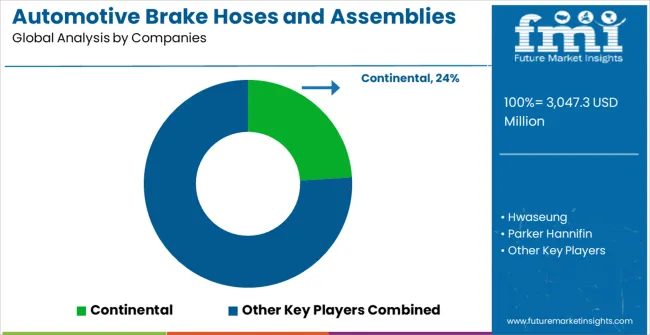
The automotive brake hoses and assemblies market is characterized by competition among established automotive component manufacturers, specialized brake system suppliers, and integrated automotive technology providers. Companies are investing in advanced materials technology, precision manufacturing capabilities, quality assurance systems, and comprehensive automotive certification programs to deliver reliable, high-performance, and safety-compliant brake hose and assembly products. Innovation in lightweight materials, high-pressure resistance, and automotive system integration is central to strengthening market position and automotive manufacturer satisfaction.
Continental leads the market with a strong focus on automotive innovation and comprehensive brake system solutions, offering integrated brake hose and assembly products that emphasize operational reliability and compatibility with automotive systems. Hwaseung provides specialized automotive component manufacturing with a focus on brake system applications and automotive quality standards. Parker Hannifin delivers advanced hydraulic and pneumatic technologies with a focus on automotive brake system integration and performance optimization. Nichirin emphasizes automotive brake hose manufacturing with a focus on quality assurance and automotive certification requirements. Flexitech focuses on flexible automotive component development and comprehensive brake system integration capabilities.
| Items | Values |
|---|---|
| Quantitative Units (2025) | USD 3,047.3 million |
| Operating Mechanism | Hydraulic, Pneumatic |
| Application | Automotive OEM, Automotive Aftermarket |
| Regions Covered | North America, Europe, East Asia, South Asia & Pacific, Latin America, Middle East & Africa |
| Countries Covered | United States, Canada, United Kingdom, Germany, France, China, Japan, South Korea, India, Brazil, Australia and 40+ countries |
| Key Companies Profiled | Continental, Hwaseung, Parker Hannifin, Nichirin, Flexitech, Summit Racing, Dayco, Grainger, Abbott Rubber, and Codan Rubber |
| Additional Attributes | Dollar sales by operating mechanism and application, regional demand trends, competitive landscape, technological advancements in brake hose materials, automotive system integration programs, safety certification requirements, and manufacturing quality enhancement strategies |
The global boundary layer wind lidar market is estimated to be valued at USD 275.5 million in 2025.
The market size for the boundary layer wind lidar market is projected to reach USD 573.1 million by 2035.
The boundary layer wind lidar market is expected to grow at a 7.6% CAGR between 2025 and 2035.
The key product types in boundary layer wind lidar market are low and medium altitude radars and high altitude radars.
In terms of application, wind power industry segment to command 40.0% share in the boundary layer wind lidar market in 2025.






Our Research Products

The "Full Research Suite" delivers actionable market intel, deep dives on markets or technologies, so clients act faster, cut risk, and unlock growth.

The Leaderboard benchmarks and ranks top vendors, classifying them as Established Leaders, Leading Challengers, or Disruptors & Challengers.

Locates where complements amplify value and substitutes erode it, forecasting net impact by horizon

We deliver granular, decision-grade intel: market sizing, 5-year forecasts, pricing, adoption, usage, revenue, and operational KPIs—plus competitor tracking, regulation, and value chains—across 60 countries broadly.

Spot the shifts before they hit your P&L. We track inflection points, adoption curves, pricing moves, and ecosystem plays to show where demand is heading, why it is changing, and what to do next across high-growth markets and disruptive tech

Real-time reads of user behavior. We track shifting priorities, perceptions of today’s and next-gen services, and provider experience, then pace how fast tech moves from trial to adoption, blending buyer, consumer, and channel inputs with social signals (#WhySwitch, #UX).

Partner with our analyst team to build a custom report designed around your business priorities. From analysing market trends to assessing competitors or crafting bespoke datasets, we tailor insights to your needs.
Supplier Intelligence
Discovery & Profiling
Capacity & Footprint
Performance & Risk
Compliance & Governance
Commercial Readiness
Who Supplies Whom
Scorecards & Shortlists
Playbooks & Docs
Category Intelligence
Definition & Scope
Demand & Use Cases
Cost Drivers
Market Structure
Supply Chain Map
Trade & Policy
Operating Norms
Deliverables
Buyer Intelligence
Account Basics
Spend & Scope
Procurement Model
Vendor Requirements
Terms & Policies
Entry Strategy
Pain Points & Triggers
Outputs
Pricing Analysis
Benchmarks
Trends
Should-Cost
Indexation
Landed Cost
Commercial Terms
Deliverables
Brand Analysis
Positioning & Value Prop
Share & Presence
Customer Evidence
Go-to-Market
Digital & Reputation
Compliance & Trust
KPIs & Gaps
Outputs
Full Research Suite comprises of:
Market outlook & trends analysis
Interviews & case studies
Strategic recommendations
Vendor profiles & capabilities analysis
5-year forecasts
8 regions and 60+ country-level data splits
Market segment data splits
12 months of continuous data updates
DELIVERED AS:
PDF EXCEL ONLINE
Automotive Hoses and Assemblies Market Size and Share Forecast Outlook 2025 to 2035
Automotive Power Steering Hoses and Assemblies Market Size and Share Forecast Outlook 2025 to 2035
Demand for Automotive Hoses and Assemblies for OEM in USA Size and Share Forecast Outlook 2025 to 2035
Automotive Brake Linings Market Size and Share Forecast Outlook 2025 to 2035
Automotive Brake Fluid Market Size and Share Forecast Outlook 2025 to 2035
Automotive Brake Booster and Master Cylinder Market Size and Share Forecast Outlook 2025 to 2035
Automotive Brake Actuation Systems Market Size and Share Forecast Outlook 2025 to 2035
Automotive Brake Shims Market Analysis - Size, Share, and Forecast 2025 to 2035
Automotive Brake System Market Growth - Trends & Forecast 2025 to 2035
Automotive Brake Friction Products Market - Trends & Forecast 2025 to 2035
Automotive Brake Pad Market - Growth & Demand 2025 to 2035
Automotive Brake Tube Market Growth - Trends & Forecast 2025 to 2035
Automotive Brake Valve Market Growth - Trends & Forecast 2025 to 2035
Automotive Brake System & Components Market Growth - Trends & Forecast 2025 to 2035
Automotive Handbrake And Clutch Cables Market
Automotive Park Brake Lever Market Growth – Trends & Forecast 2024-2034
Automotive Vacuum Brake Booster Market Size and Share Forecast Outlook 2025 to 2035
Automotive Carbon Brake Rotors Market Growth - Trends & Forecast 2025 to 2035
Automotive Rubber Hoses Market
Automotive Sintered Brake Pads Market Size and Share Forecast Outlook 2025 to 2035

Thank you!
You will receive an email from our Business Development Manager. Please be sure to check your SPAM/JUNK folder too.
Chat With
MaRIA